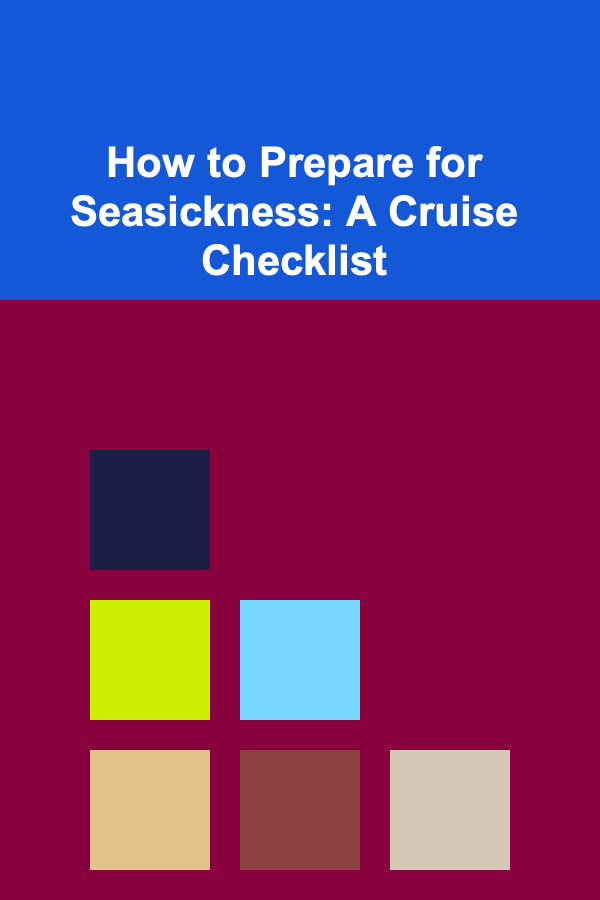
How to Prepare for Seasickness: A Cruise Checklist
ebook include PDF & Audio bundle (Micro Guide)
$12.99$10.99
Limited Time Offer! Order within the next:

Going on a cruise can be an exciting and memorable vacation, offering the chance to visit exotic destinations, enjoy luxury amenities, and experience the open sea. However, for some travelers, the thought of being on the water can bring with it the fear of seasickness. Seasickness, or motion sickness, occurs when the body's balance system becomes confused by the motion of the boat, leading to symptoms such as nausea, dizziness, and sweating. While some people are more prone to seasickness than others, it can affect anyone, regardless of experience or the size of the ship.
If you are planning a cruise and are worried about seasickness, there are steps you can take to prepare yourself for the journey. With the right approach, you can minimize your risk and even avoid seasickness altogether. In this article, we will provide a comprehensive guide and a checklist to help you prepare for seasickness and ensure a smoother and more enjoyable cruise experience.
Understanding Seasickness
Before we dive into the checklist, it's important to understand what seasickness is and why it happens. Seasickness is a type of motion sickness that is caused by the movement of a boat or ship. When the boat sways or rocks, your inner ear (which helps maintain balance) detects the motion. However, if your eyes are focused on a stationary object, like the horizon or the inside of the cabin, your brain receives conflicting signals---one from the inner ear that senses movement and another from your eyes that shows you are still. This confusion leads to the symptoms of seasickness.
The symptoms of seasickness can range from mild to severe and may include:
- Nausea and vomiting
- Dizziness and lightheadedness
- Sweating or cold chills
- Headaches
- Fatigue or weakness
- Increased salivation
Seasickness can occur on any watercraft, but it's most commonly experienced on smaller boats, ferries, or during rough weather conditions. Cruise ships, due to their large size, tend to experience less motion than smaller vessels, but passengers can still feel discomfort, especially during rough seas.
Cruise Checklist: How to Prepare for Seasickness
1. Choose the Right Cabin
One of the first steps in preparing for seasickness is selecting the right cabin. The location of your room on the cruise ship can have a significant impact on how much motion you feel. Ideally, you want to stay in a cabin that minimizes the sensation of rocking.
Tips for Choosing the Best Cabin for Stability:
- Midship Rooms: The middle of the ship is the most stable part. Choose a room located near the ship's center, either on a lower deck or mid-level. The higher up you go on the ship, the more likely you are to experience motion.
- Rooms on Lower Decks: Lower decks tend to be more stable as they are closer to the waterline, reducing the feeling of sway.
- Avoid Rooms at the Front or Back: The bow (front) and stern (back) of the ship tend to feel more motion, as they are the areas that rise and fall the most with the movement of the ship.
Choosing the right cabin can provide a more comfortable experience and reduce your risk of seasickness, especially if you are sensitive to motion.
2. Take Motion Sickness Medication
For many people, taking medication before and during the cruise is the most effective way to prevent seasickness. There are several over-the-counter and prescription medications available, each with different active ingredients, that can help combat the symptoms of seasickness.
Common Medication Options:
- Dimenhydrinate (Dramamine): This is one of the most common and widely available motion sickness medications. It works by blocking signals in the brain that trigger nausea. It can be taken before or during your cruise.
- Meclizine (Bonine): Another over-the-counter medication, Bonine is known for causing less drowsiness than Dramamine and is typically taken 30 minutes before boarding.
- Scopolamine (Transderm Scop): This prescription medication comes in the form of a patch that is placed behind your ear several hours before your trip. It delivers medication steadily to prevent nausea and is often recommended for people who experience severe motion sickness.
- Ginger Supplements: Natural remedies, such as ginger, have been shown to help reduce nausea. Ginger candies, capsules, or tea are a great option for those who prefer a non-pharmaceutical solution.
- Prescription Medications: If you are prone to severe seasickness, consult your doctor for a prescription medication that is specifically designed to prevent or alleviate motion sickness.
Be sure to talk to your healthcare provider about which option is best for you, especially if you have any pre-existing conditions or are taking other medications. Always follow the recommended dosage instructions.
3. Pack Seasickness Remedies
In addition to medication, there are other remedies that may help relieve or prevent seasickness. Some people prefer natural or holistic solutions, while others find comfort in physical products. Consider packing these items for your cruise:
Natural Remedies and Products:
- Acupressure Bands: These bands apply gentle pressure to acupressure points on your wrists, which some people find helpful in preventing nausea.
- Essential Oils: Peppermint and lavender oils are popular for soothing the stomach and relieving nausea. You can carry a small bottle and inhale the aroma or use it in a diffuser.
- Sea-Bands: Sea-Bands are a type of wristband that applies pressure to specific acupressure points. Many people report feeling relief from motion sickness with these bands.
- Hydration: Dehydration can worsen the symptoms of seasickness. Be sure to drink plenty of water throughout the day to stay hydrated.
- Snacks: Eating light, easy-to-digest foods like crackers, ginger ale, or bananas can help settle your stomach and reduce nausea.
Packing these remedies will give you options if you begin to feel unwell during your cruise.
4. Stay on Deck and Look at the Horizon
Another helpful tip is to stay outside as much as possible, especially if you start feeling queasy. The fresh air and the ability to see the horizon can help your brain process the motion and reduce the sensation of seasickness.
Tips for Staying on Deck:
- Look at the Horizon: Focusing on the horizon can help align the conflicting signals your brain is receiving from your inner ear and eyes. This visual cue helps your body recognize that you are moving, which can reduce the symptoms of seasickness.
- Breathe Fresh Air: Step outside to the deck and breathe in fresh air. Stale air can worsen nausea, so spending time outdoors can offer immediate relief.
- Walk Around: Gentle movement, such as walking around the deck, can also help settle your stomach. Avoid lying down unless you are feeling extremely unwell.
Being outside in the fresh air and focusing on the horizon helps your body adjust to the movement of the ship, reducing the chances of seasickness.
5. Mind Your Eating and Drinking Habits
What you eat and drink before and during your cruise can have a significant impact on how well you tolerate the motion of the ship. Certain foods and beverages can aggravate nausea, while others may help soothe your stomach.
Tips for Eating and Drinking:
- Eat Light, Frequent Meals: Avoid heavy, greasy foods that can upset your stomach. Instead, try to eat small, light meals throughout the day.
- Avoid Alcohol: Drinking alcohol can increase the likelihood of seasickness, especially if consumed in large quantities. Limit your alcohol intake and drink plenty of water to stay hydrated.
- Avoid Strong Odors: Strong food odors, such as those from fried foods or perfumes, can trigger nausea. Try to avoid these odors when possible.
- Choose Ginger: Ginger is known for its natural anti-nausea properties, so consider eating ginger-flavored snacks or drinking ginger tea to settle your stomach.
Taking care of your eating and drinking habits will help you maintain your energy and reduce the chances of feeling seasick.
6. Know When to Rest
If you start to feel the symptoms of seasickness, it's important to listen to your body and rest when necessary. Overexerting yourself can worsen nausea and make recovery more difficult.
Tips for Resting:
- Find a Comfortable Spot: Lie down in a position where your head is elevated, preferably in the middle of the ship. Keep your eyes closed or focus on a stationary object.
- Take Short Naps: Sometimes a short nap can help your body recalibrate and reduce the symptoms of seasickness.
- Avoid Strong Stimuli: When resting, avoid loud noises, bright lights, or strong odors, as these can exacerbate seasickness.
Knowing when to rest is essential to recovery, and sometimes a break from the motion can help you feel better.
Conclusion
Seasickness doesn't have to ruin your cruise experience. By preparing ahead of time and following the tips outlined in this checklist, you can significantly reduce your chances of feeling unwell and enjoy your time on the water. Whether it's choosing the right cabin, taking medication, or bringing along natural remedies, there are several strategies you can employ to make your cruise more comfortable.
Remember, everyone reacts differently to motion, so it's essential to experiment and find what works best for you. With the right preparation and mindset, you can set sail with confidence, knowing that you are well-equipped to handle any potential seasickness. Happy cruising!
Reading More From Our Other Websites
- [Home Storage Solution 101] How to Use Vertical Storage to Free Up Floor Space
- [Organization Tip 101] How to Build a Wheelchair Ramp for Easy Access to Your Front Door
- [Organization Tip 101] How to Organize Your Closet by Color
- [Toy Making Tip 101] The Magic of Upcycling: Turning Household Items into Fun Toys for Children
- [Personal Finance Management 101] How to Navigate Personal Finance for Couples: Building a Strong Financial Foundation Together
- [Organization Tip 101] How to Maintain a Clutter-Free Outdoor Dining Space
- [Survival Kit 101] Best Urban Survival Kit for Natural Disasters: What City Dwellers Need
- [Organization Tip 101] How to Incorporate Mirrors for a Stylish Closet Space
- [Home Pet Care 101] How to Make a DIY Pet Collar for Your Beloved Animal
- [Organization Tip 101] How to Keep Your Pet's Area Clean and Odor-Free

How to Make a Checklist for Preparing Your Resume and Portfolio for Interviews
Read More
How to Manage Your Handmade Agency Business as a Side Hustle
Read More
How to Optimize Your ProA7Plus for Advanced Security Features
Read More
How to Organize Family Chores and Responsibilities Effectively
Read More
Stand Out in Consulting: Strategies for Delivering Value to Clients
Read More
Blind Wine Tasting: A Fun and Engaging Guide
Read MoreOther Products

How to Make a Checklist for Preparing Your Resume and Portfolio for Interviews
Read More
How to Manage Your Handmade Agency Business as a Side Hustle
Read More
How to Optimize Your ProA7Plus for Advanced Security Features
Read More
How to Organize Family Chores and Responsibilities Effectively
Read More
Stand Out in Consulting: Strategies for Delivering Value to Clients
Read More